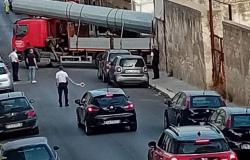Belt of fire, this is how the Palestinians have called the circular bombings since October 7th, as if they were a vortex or a tornado. This is the expression that some of the survivors of the Israeli raids on the al-Sardi school in the Nuseirat refugee camp in central Gaza used yesterday: a belt of fire.
«We were inside the school and suddenly we were bombed, people were torn to pieces – Anas al-Dahouk tells al Jazeera – This building housed families and young people, they gave no warning.”
The al-Sardi school is run by the United Nations, but has no longer been a school since 7 October. The classrooms are full of displaced people, around 6 thousand, mattresses and clothes hanging outside to dry. The structure is the same as all UNRWA schools in Palestine, the agency for Palestinian refugees: white and blue paint, the colors of the United Nations, three floors and a balustrade that runs along the entire building. A way to provide shade, here the sun beats down strongly and the covered balcony keeps the rays away from the classroom doors.
AT SCHOOL the children of Gaza have not been there for eight months and as with every offensive, thousands of families take refuge in UN centres, whether schools, warehouses or clinics. They think they are safer: “UN” is written on the roof in large letters. They have not been safe for years, even less so in this attack: 180 UN centers have been hit by Israeli bombings.
The other night it happened at 1.30, many were already asleep or trying. Three missiles, survivors say, gutted the second and third floors. Journalist Hind Khoudary went inside and showed it on video: the walls facing the outside were completely blown away, the others still standing were blackened.
DRIED BLOOD on the ground, a huge hole in the ceiling, the personal objects of the displaced people – which are now limited to mattresses and clothes – full of dust. A man collects pieces of bodies, the bodies are no longer there, the paramedics took them away during the night.
They wrapped them in plastic bags later, in the hospital in Deir al Balah. When they loaded them into the ambulance, they were wrapped in the blankets they had been sleeping on shortly before.
“It was dark, there was no electricity, it was very difficult to recover the victims”, says Ayman Rashed, a displaced person from Gaza City, toAp. He recovered five bodies, including two children and an elderly man. One of the children had a crushed skull.
The toll speaks of 40 killed, including 14 children and nine women; 74 injured. The Israeli army admitted the raid but said it had targeted “twenty or thirty” Hamas and Islamic Jihad militiamen who had taken part in the October 7 attack (1,100 Israelis killed, 250 kidnapped).
Spokesman Peter Lerner added that he was not aware of any civilian casualties but was aware that the school was being used as a military center. He provided no evidence. Hamas denies it. UNRWA calls for an independent investigation and says it did not receive any warning before the raid: “We communicate the coordinates of our facilities, targeting them or using them for military purposes cannot become the norm.”
But in the meantime, something is known. You know, they wrote yesterday Guardian And al Jazeera, that the three missiles used were US, the Gbu 39: you can see from the fragments, photographed and filmed. The same ones used ten days ago in the tent massacre in Tal al-Sultan, Rafah.
THE OFFENSIVE yesterday it did not stop in Nuseirat: the Israeli army hit a house in az-Zawayda, killing a child, the Shati camp, other victims, and again Deir al Balah, in the center, and Rafah, in the south. The count of Palestinian deaths since October 7 has exceeded 36,600, in addition to at least 10,000 missing and 83,000 wounded. Yesterday the death of a 34-year-old Israeli soldier was also recorded on the border with Egypt.
International, political and legal pressure from the Security Council and the International Court of Justice was of no avail. Yesterday a group of countries – including Argentina, Brazil, France, Germany, Canada, Spain and the United Kingdom – published a joint statement of “full support” for the truce agreement presented on 31 May by US President Biden: calls are made to Hamas to accept it and defines Israel as “ready to move forward”.
ON THE FIELD the situation appears different: the Netanyahu government is divided and it is not yet clear whether Joe Biden’s leap forward was actually agreed with Tel Aviv, given that the prime minister – pressured by his ultra-right allies – insists on saying that the offensive will not end.
And Hamas, although yesterday Egypt spoke of “positive signals” from the Islamic movement and of a response within days, through Sami Abu Zuhri said it welcomed “Biden’s ideas” but complained about the “failure to mention the end of aggression or withdrawal”: “The Israeli document speaks of open negotiations without an expiry date and of a phase in which the occupation will regain the hostages and then resume the war.”
The proposal that Biden attributes to Tel Aviv and published yesterday exclusively by Middle East Eye However, it provides for the withdrawal of the Israeli army from Gaza and a permanent ceasefire in the second phase. It remains to be seen how much the proposal read in public by Biden really coincides with that of Israel. According to Hamas, there are different proposals on the table, “open to different interpretations”.
He would confirm it Haaretzaccording to which Tel Aviv is opposing the draft resolution that the United States will present to the UN Security Council in the coming days.






